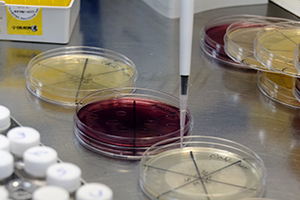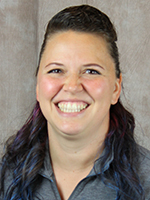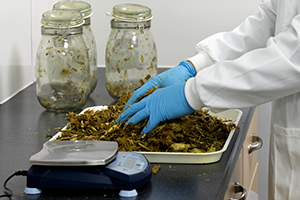
A peek inside: What goes into making a great inoculant
 By Mark Leggett, Ph.D., research and development manager, Volac International Ltd.
By Mark Leggett, Ph.D., research and development manager, Volac International Ltd.Bacteria are the driving force in the silage’s fermentation. Silage inoculants are applied to speed up the fermentation and preserve silage dry matter. Ensuring your silage is fermented by the best and most efficient bacterial strains starts in the laboratory.
Identifying the best bacteria for the job requires isolating and testing thousands of different bacterial strains. Desirable bacteria are screened, identifying those most likely to be effective silage inoculants. This screening looks for key characteristics vital to performance in an efficient silage fermentation: pH tolerance, desired substrates and fermentation products, and osmotolerance, a measure of their ability to resist the drier conditions found in some forages. Using genomic analysis, we can screen for many different traits, such as specific metabolic capability or improved ability to compete with other bacteria.
Next, we evaluate their ability to produce great silage in both small-scale fermentations in the laboratory (such as bucket, jar or bag silos) as well as larger, on-farm testing.
 Bacteria that make the grade are further validated through various approval processes. In the European Union, bacteria must be registered as feed additives and independently assessed by the European Food Safety Authority (EFSA), a process that must:
Bacteria that make the grade are further validated through various approval processes. In the European Union, bacteria must be registered as feed additives and independently assessed by the European Food Safety Authority (EFSA), a process that must:
- Confirm that the bacteria do not pose any risk for the target species, consumer or environment.
- Evaluate their ability to make good silage in a range of different crops and conditions.
- Assess our manufacturing process, ensuring batch reproducibility, as well as the quality and stability of our bacteria.
In addition, at Volac, we submit our strains for validation by academic experts in the fields of agriculture and silage-making. This ensures that our science stands up to the rigors of peer review.
The best inoculants for the farm
 By Michelle Chang-Der Bedrosian, Ph.D., Vita Plus forage products and dairy technical service specialist
By Michelle Chang-Der Bedrosian, Ph.D., Vita Plus forage products and dairy technical service specialist
While vetting an inoculant starts in a laboratory, the process doesn’t end there. At Vita Plus, we also conduct our own screening processes to ensure the inoculant will effectively meet the needs of farming customers.
We first scrutinize the research on the bacterial strain and inoculant, looking at results, consistency, scale of the trials, and the reputation and bias of the scientists. For example, was the research done internally by the manufacturer or was it conducted by an unbiased third party? How many times was it repeated? How consistent are the results?
 The inoculants are then evaluated for mixability, viability and stress tolerance. We need to be sure that the inoculant will survive shipping (especially during hot weather). Given the high degree of variability among forage crops, we want a product that will be effective on a variety of crops, conditions and dry matter contents. Finally, the product needs to be easy for producers and custom harvesters to handle and apply correctly.
The inoculants are then evaluated for mixability, viability and stress tolerance. We need to be sure that the inoculant will survive shipping (especially during hot weather). Given the high degree of variability among forage crops, we want a product that will be effective on a variety of crops, conditions and dry matter contents. Finally, the product needs to be easy for producers and custom harvesters to handle and apply correctly.
Vita Plus consultants are relentlessly focused on providing service and technology to help farms get the most from their forage. Forage inoculants are no exception to this rule. Thus, silage inoculants are only introduced to the farm when extensive laboratory and on-farm testing has demonstrated their value and effectiveness.
| Category: |
Consumer communication Forage Foundations Forage inoculants |

